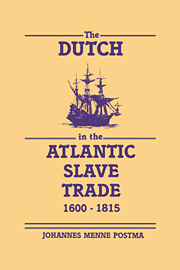Book contents
- Frontmatter
- Contents
- List of tables, figures, and maps
- Preface
- 1 Foundations of the slave traffic, 1600–61
- 2 Curaçao and the asiento trade, 1650–1730
- 3 The Dutch on the West African coast
- 4 Trade and politics on the African coast
- 5 Volume of African exports and origins of slaves
- 6 Organization and mechanics of the trade
- 7 The triangular trade
- 8 The Dutch plantation colonies under WIC monopoly, 1618–1738
- 9 The era of the free trade, 1730–80
- 10 The slaves: their treatment and mortality
- 11 Finances, marketing, and profitability
- 12 The end of the Dutch slave trade, 1781–1815
- Appendixes
- Bibliography
- Index
8 - The Dutch plantation colonies under WIC monopoly, 1618–1738
Published online by Cambridge University Press: 16 September 2009
- Frontmatter
- Contents
- List of tables, figures, and maps
- Preface
- 1 Foundations of the slave traffic, 1600–61
- 2 Curaçao and the asiento trade, 1650–1730
- 3 The Dutch on the West African coast
- 4 Trade and politics on the African coast
- 5 Volume of African exports and origins of slaves
- 6 Organization and mechanics of the trade
- 7 The triangular trade
- 8 The Dutch plantation colonies under WIC monopoly, 1618–1738
- 9 The era of the free trade, 1730–80
- 10 The slaves: their treatment and mortality
- 11 Finances, marketing, and profitability
- 12 The end of the Dutch slave trade, 1781–1815
- Appendixes
- Bibliography
- Index
Summary
The first two chapters of this book describe how the Dutch got involved in the Atlantic slave trade during the seventeenth century, first to supply their new plantation colony in northern Brazil, and then to make profits by supplying the Spanish mainland colonies with slaves either through the asiento or by means of illicit trade. As the asiento slave trade declined toward the end of the seventeenth century, Dutch slavers found a growing demand for their human cargoes in the various Dutch plantation colonies of Guiana, then also known as the Wild coast, in northwestern South America, between the river deltas of the Amazon and the Orinoco. The next two chapters will focus on the slave traffic to Surinam and the settlements in present-day Guyana: Berbice, Essequibo, and Demerara, as the Dutch identified their plantation colonies there.
The Guiana coast, which today includes the countries of Guyana, Surinam, and French Guiana (as well as portions of Brazil and Venezuela), had been the object of numerous colonization attempts during the sixteenth and seventeenth centuries by Dutch, English, and French settlers. The Dutch may have been pioneers in the area by establishing a settlement on the Essequibo River in the second half of the sixteenth century. But this, like many similar attempts afterward, had failed as a result of the hostile physical environment or the opposition of the indigenous population, the Caribs and the Arawaks. The Portuguese also eliminated a number of Dutch settlement attempts in the Amazon River delta.
- Type
- Chapter
- Information
- The Dutch in the Atlantic Slave Trade, 1600–1815 , pp. 174 - 200Publisher: Cambridge University PressPrint publication year: 1990



